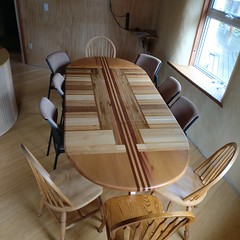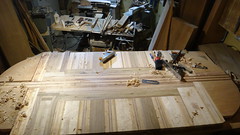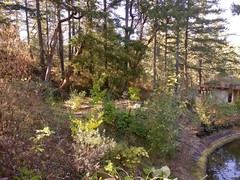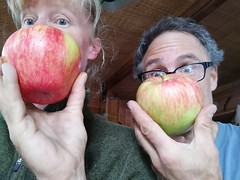One of the most important additions to a food forest are the plants that fix atmospheric nitrogen in the soil, allowing the mycelium to share the food with surrounding plants, thus removing or greatly reducing the need for manure inputs. We use a variety of low growing common plants, trees and shrubs.
The common understory plants
Sepp Holzer Sweet Lupine
In Austria, there are lupines that have seeds that are not bitter. These lupine seeds are edible. The lupines are a beautiful nitrogen fixing plant.
Fava Beans
We use two kinds of Fava… the small seed variety which grows to 6 feet and is a chop and drop nitrogen fixing soil builder, and the more common large seed shorter plant that we use for dried stores for the winter. We plant twice per year, once in spring, and again in October. The october plantings pop above the soil, handle – 10C, unthaw and look great. Initially we inoculated our seeds, but this is now no longer needed.
Orca bush beans
Plant in spring, and the bush style bean will produce! We dry them and they are a great keeper for the winter.
Various Lupine (including the one from Sepp Holzer’s land)
We are working on each tree having its own lupine… and it so happens that a friend brought some back from a visit to Sepp Holzer’s farm in Austria.
Austrian Winter field pea
Broadcast heavily to act as a ground cover, this along with the Lincoln Homesteader are self seeding, proving to be a great resource for both us and the soil. They go in in February, they sprout and provide ground cover, food for the chickens, the young’s leaves are a great snack, or early wonderful green in a salad, and the dried beans got us through the winter. We cook them long and slow, best in the cob oven overnight.
Lincoln Homesteader pea
Like the Austrian Winter Field pea, we originally broadcast them after soaking for 12 hrs and inoculating them. They are hardy, and have re-seeded and growing mid winter and handling minus 10C along with the Austrian pea. They make up a big part of our diet now.
Hairy Vetch
The hairy vetch is a low growing feathery ground cover great for holding back unwanted weed seeds. Is is also handling the Minus 10C winters well.
Clovers
We use a variety of clovers for different purposes. White Dutch is a perennial use for pathways and as a permanent ground cover. Red Crimson clover is an annual that we use as a soil builder, green manure and nitrogen fixer on areas that we want to prep for other plantings. Sweet White clover grows 7 feet tall and flowers throughout the summer – a real hit with the bees.
Honey Locust – Gleditsia triacanthos
A tall 60′-80′ open airy deciduous tree with medium growth rate, hardy to zone 3, tolerating many soil types. It is juglaone tolerant an thus works well with walnuts. And it is edible: seed – raw or cooked, can contain up to 30% sugar, where the young seeds taste like raw peas. The seeds have also been roasted and used as a coffee substitute. And for the beer drinker, young seedpod pulp is sweet and can be eaten raw or made into sugar or a pleasant tasting drink/beer.
GOUMI – ELAEAGNUS MULTIFLORA
A power house plant, hard to access, that is a choice edible berry, growth 9′ x 6′, that is a nitrogen fixer, mulcher, and can grow in poor soils, part shade, and once established (3 yrs) is drought tolerant. Hardy to minus 25F. High in vitamins A, C, and E, has flavenoids and even essential fatty acids.
Considered one of the most useful plants by PFAF…
Red Gem Goumi – Available spring 2014
From the far east of Russia, high quality, large and tasty fruit
Sweet Scarlett Goumi– Available spring 2014
From the Main Botanical Garden in Kiev, cultivated for its fruit.
Elaeagnus Multiflora Goumi – seedling
Cross pollinated seed so that genetic variation and attributes from the parents can progress and continue to be expressed. The benefit of seed propagated plants comes from the epigenetic expression of genes turned on by our climate and conditions.
AUTUMN OLIVE – ELAEAGNUS UMBELLATA
An Elaeagnus, which means it is a nitrogen fixing plant. Hardy to minus 30F. The autumn olive is (like the goumi) one of the power house plants. that is a choice edible berry, growth 14′ x 13′, that is a nitrogen fixer, mulcher, and can grow in poor soils, part shade, and once established (3 yrs) is drought tolerant. We grow ours amongst the arbutus trees, in pockets of rich, humus heavy soils made from leaf mulch and sawdust composted on the driveway and scraped up. Every fruit and nut tree is best served to have its own nitrogen fixer.
Autumn Olive is jug lone tolerant, so it works well with walnuts.
More info from PFAF…
Amber Autumn Olive
A Japanese variety that produces large, sweet, golden yellow fruits in late summer.
Ruby Autumn Olive
Produces large bright red fruit
Garnet Autumn Olive
Seven Ravens/Geoff Johnson Autumn Olive Cultivar
Considered by some to be an improved variety, but not classified as such yet, it is proving to be a very impressive producer of large red fruits.
SEABUCK THORN – HIPPOPHAE RHAMNOIDES
Another power house! Male and female plants, tea from the leaves of the male, fruits extremely high in vitamin A,C and E from the females, and a highly useful oil great for psoriasis and eczema. Hardy to minus 40F, no disease or pest problems, can grow in poor sandy and gravely soils. There are German and Russian varieties, mostly due to the fact that it is been researched and bred in areas that deem its esteemed value. Plants For A Future considers this one of their top 20 most useful plants out of the 7000 they have listed. Life span of a tree has been reported to be 7-8 years, so renewal planted needs to be considered.
More info at PFAF…
Cultivation Information from 1996 paper from Hort Tech…
BC Government Info Sheet on Seabuck Thorn
German Cultivars
German varieties are more vigorous than the Russian varieties, growing 8′-12′ in height, and have a higher acid content (more vitamin C). A later ripening crop than Russian, and the juice by itself is good quality.
Askola Sea Berry – High Vit C and E
Leikora Sea Berry – good fresh eating – very large berries, late.
Golden Sweet Sea Berry – German – Female That said Golden Sweet is indeed sweet and thus can be eaten fresh and does not need to be blended with other fruits to cut the acid.
Hergo Sea Berry – most widely planted in Germany, medium-early
Orange Energy Sea Berry – new patented cultivar in North America, medium early and high yields, few thorns .
German varieties are more vigorous than the Russian varieties, growing 8′-12′ in height, and have a higher acid content (more vitamin C). Orange Energy (as poorly named as it is) is noted for its huge abundant crops, and its vitamin rich makeup. A juicer.
Russian Cultivars
Russian varieties are smaller and less vigorous than the German, and thus fit well in the nooks and crannies, and places where a nitrogen fixing niche needs to be filled – and earlier to ripen.
Titan Sea Berry – largest of the Russian at 10 ft (though at a slow pace), very large flavourful and aromatic fruit
Russian Orange Sea Berry – Attractive plant with dark orange fruit and slender long foliage – High ornamental value on its own
Star of Altai Sea Berry – unusually sweet berries suited for dry conditions, large reddish orange berries, and very long tray leaves.
Botanica Sea Berry – Very large bright orange flavourful berries, ripen mid August
Sirola Sea Berry – Cross between Russian and German – SWEET and easily picked.
Male
One male will wind pollinate up to 8 females.
RUSSIAN OLIVE – ELAEAGNUS ANGUSTIFOLIA
Also called Oleaster, this nitrogen fixing tree, growing to 20′ tall and wide, is hardy to zone 2, is jug lone tolerant, and produces edible fruits similar to Autumn Olive and Goumi. It can handle shitty soil (not fertile soil), needs a sunnier location, and is drought tolerant. It is jug lone tolerant = walnut friendly.
Good info at PFAF…
SIBERIAN PEA SHRUB – CARAGANA ARBORESCENS
Siberian Pea Shrub
This was a tree that we looked long and hard at for over a year. It is a medium to fast growing perennial shrub to 12 feet, that is leguminous, handles drought, all soil types, is food for chickens and humans (has edible young pods and mature seeds), a nitrogen fixer, and a soil stabilizer for steep slopes. Considered one of the top plants for agroforestry by PFAF.
Black Locust – Robinia Pseudoacacia
This is one of the most useful trees around and is edible if processed correctly. A rapidly growing, deciduous tree that is native to North America, a member of the pea and bean family (Leguminosae) with decay-resistant wood used for fence posts, and floors. The flowers are a nectar source for bees and yield a high quality honey. Black locust is also planted to control erosion and is used for soil enrichment (it is a nitrogen fixer, by means of bacteria inside special root nodules. Juglone Tolerant – friend with walnuts.
More info at PFAF…









